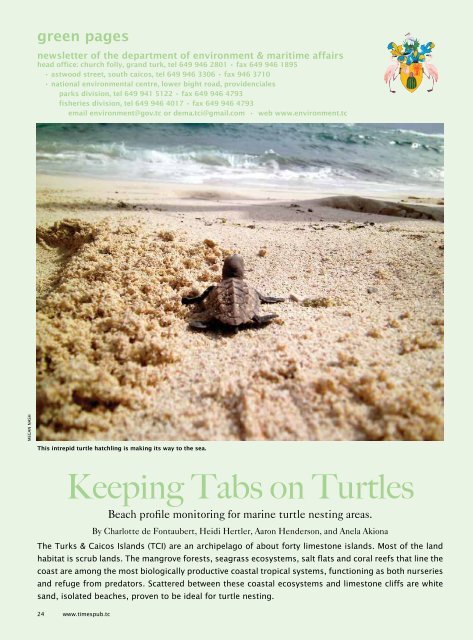Times of the Islands Summer 2015
Presents the "soul of the Turks & Caicos Islands" with in-depth features about local people, culture, history, environment, businesses, resorts, restaurants and activities.
Presents the "soul of the Turks & Caicos Islands" with in-depth features about local people, culture, history, environment, businesses, resorts, restaurants and activities.
You also want an ePaper? Increase the reach of your titles
YUMPU automatically turns print PDFs into web optimized ePapers that Google loves.
green pages<br />
green pages newsletter <strong>of</strong> <strong>the</strong> department <strong>of</strong> environment & maritime affairs<br />
newsletter <strong>of</strong> <strong>the</strong> department <strong>of</strong> environment & maritime affairs<br />
head <strong>of</strong>fice: church folly, grand turk, tel 649 946 2801 • fax 649 946 1895<br />
• astwood street, south caicos, tel 649 946 3306 • fax 946 3710<br />
• national environmental centre, lower bight road, providenciales<br />
parks division, tel 649 941 5122 • fax 649 946 4793<br />
fisheries division, tel 649 946 4017 • fax 649 946 4793<br />
email environment@gov.tc or dema.tci@gmail.com • web www.environment.tc<br />
HEIDI HERTLER<br />
Turtles are commonly observed in <strong>the</strong> near shore reefs around <strong>the</strong> Turks & Caicos <strong>Islands</strong>.<br />
MEGAN NASH<br />
This intrepid turtle hatchling is making its way to <strong>the</strong> sea.<br />
Keeping Tabs on Turtles<br />
Beach pr<strong>of</strong>ile monitoring for marine turtle nesting areas.<br />
By Charlotte de Fontaubert, Heidi Hertler, Aaron Henderson, and Anela Akiona<br />
Near shore coral reefs are extremely productive, supporting<br />
most <strong>of</strong> <strong>the</strong> TCI economy, ei<strong>the</strong>r through fisheries<br />
or tourism, along with resident and transient marine turtles.<br />
TCI waters support regionally significant foraging<br />
aggregations <strong>of</strong> green (Chelonia mydas) and hawksbill<br />
(Eretmochelys imbricata) turtles, and, to a lesser extent,<br />
loggerhead (Caretta caretta) turtles, all species which<br />
have been designated as endangered or critically endangered<br />
by <strong>the</strong> International Union for <strong>the</strong> Conservation <strong>of</strong><br />
Nature (IUCN). They are also listed under Annex I <strong>of</strong> <strong>the</strong><br />
Convention on International Trade in Endangered Species<br />
(CITES), and while this listing protects <strong>the</strong>se species from<br />
international trade between parties to CITES, <strong>the</strong>y are still<br />
harvested throughout <strong>the</strong> Caribbean, largely for domestic<br />
consumption. Marine turtles utilize a variety <strong>of</strong> habitats<br />
throughout <strong>the</strong>ir lives including sandy beaches, coral<br />
reefs, seagrass beds, and o<strong>the</strong>r shallow nearshore foraging<br />
areas.<br />
Sea turtles are one <strong>of</strong> <strong>the</strong> most ancient groups <strong>of</strong><br />
animals. They are primarily found in warm and temperate<br />
waters around <strong>the</strong> world. Many migrate over 1,000<br />
miles from feeding grounds to nesting beaches, <strong>the</strong> same<br />
beaches from where <strong>the</strong>y were born. Female green turtles<br />
mate every two to four years, usually in June through<br />
September; while female hawksbills breed every two<br />
years, usually in April through November. Sand temperature<br />
determines <strong>the</strong> sex <strong>of</strong> <strong>the</strong> turtle, where below 30ºC is<br />
predominantly male and above is predominately female.<br />
Hatchlings emerge at night from buried nests to make<br />
<strong>the</strong>ir way to <strong>the</strong> sea. Turtles feed on jellyfish, seaweed,<br />
crustaceans (crabs and shrimp), sponges, and algae, all<br />
<strong>of</strong> which are abundant around <strong>the</strong> Turks & Caicos <strong>Islands</strong>.<br />
Whilst <strong>the</strong> full extent <strong>of</strong> <strong>the</strong> impacts <strong>of</strong> climate change<br />
on marine and coastal ecosystems is hard to predict in<br />
any significant detail, many <strong>of</strong> <strong>the</strong>se impacts have already<br />
been observed and felt, globally and in <strong>the</strong> Turks & Caicos.<br />
For instance, sea-surface temperatures have increased,<br />
sea-level has measurably risen, current pattern changes<br />
have been documented, and even water pH balance has<br />
changed as a result <strong>of</strong> ocean acidification. These impacts<br />
are <strong>of</strong> great concern for <strong>the</strong> survival <strong>of</strong> marine turtles.<br />
Temperature pr<strong>of</strong>oundly influences many aspects <strong>of</strong><br />
marine turtle life behavior and distribution, from adults’<br />
distribution to sex ratios <strong>of</strong> hatchlings. Elevated sea<br />
surface temperature and changes in precipitation affect<br />
turtle growth rate, nesting periodicity and onset <strong>of</strong> nesting<br />
season, incidence <strong>of</strong> disease, and change predator<br />
distribution and prey abundance. Sea-level rise affects<br />
beach erosion pattern and size, thus reducing nesting<br />
site option and success. Altered strengths and locations<br />
<strong>of</strong> sea-surface currents affect migration patterns and alter<br />
distribution <strong>of</strong> juveniles.<br />
The Turks & Caicos <strong>Islands</strong> (TCI) are an archipelago <strong>of</strong> about forty limestone islands. Most <strong>of</strong> <strong>the</strong> land<br />
habitat is scrub lands. The mangrove forests, seagrass ecosystems, salt flats and coral reefs that line <strong>the</strong><br />
coast are among <strong>the</strong> most biologically productive coastal tropical systems, functioning as both nurseries<br />
and refuge from predators. Scattered between <strong>the</strong>se coastal ecosystems and limestone cliffs are white<br />
sand, isolated beaches, proven to be ideal for turtle nesting.<br />
24 www.timespub.tc<br />
<strong>Times</strong> <strong>of</strong> <strong>the</strong> <strong>Islands</strong> <strong>Summer</strong> <strong>2015</strong> 25

















